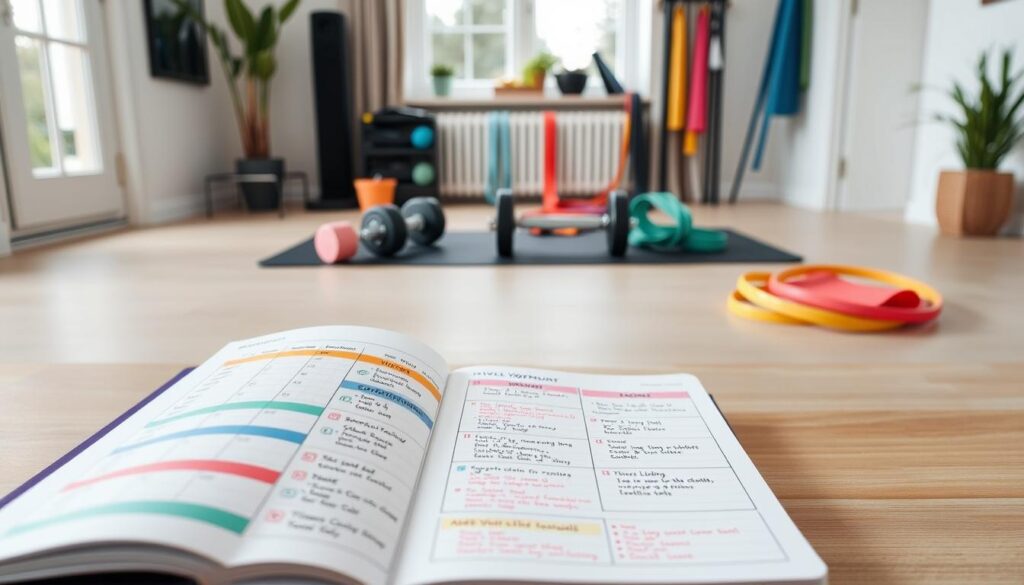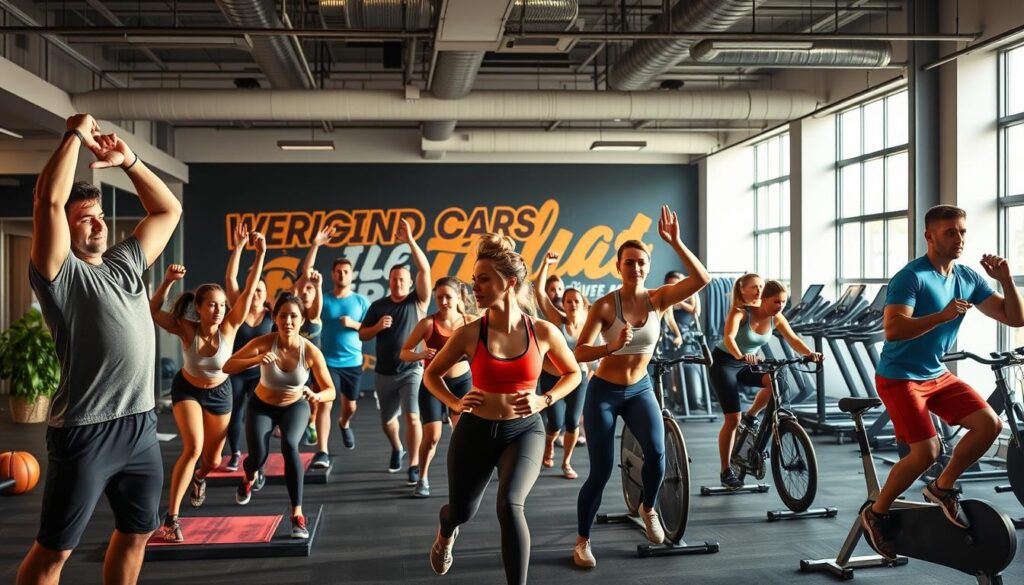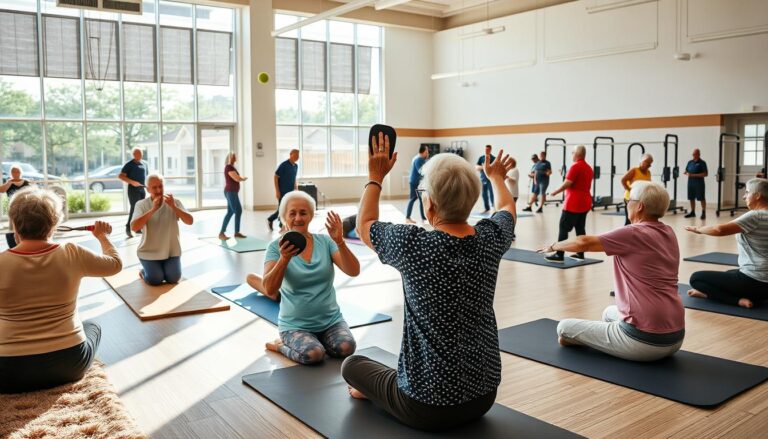Find the Perfect Workout Routine for You
Starting a fitness program can change your life. The CDC says you need 150 minutes of moderate exercise each week. Plus, two days of strength training. It’s important to find a routine that fits your goals, lifestyle, and what you like.
Whether you want to improve your heart health, get stronger, or have more energy, a plan made just for you works best. This way, you’re more likely to stick with it and see lasting results.
A study from the University of Glasgow found that cycling 30 miles a week can cut your risk of heart disease and cancer by almost half. HIIT workouts, as shown in the Journal of Physiology, are just as good as traditional cardio but take less time. But, don’t forget about rest.
Resting for 48 hours between muscle groups and taking rest days is key to avoid overtraining. The American College of Sports Medicine says it’s better to have shorter, focused workouts. These often give you better results than spending hours at the gym.
Key Takeaways
- CDC guidelines recommend 150 minutes of moderate activity weekly plus two days of strength training.
- HIIT workouts match traditional cardio in health benefits, backed by 2013 scientific research.
- Incorporate rest days to avoid burnout and enhance performance.
- Cycling 30 miles weekly reduces major disease risks by nearly 50%, per University of Glasgow data.
- Effective workout routines adjust every three to four weeks to challenge muscles and prevent plateaus.
Understanding Your Fitness Goals
Before picking best workout routines, you must know your fitness goals. Without clear goals, even the best customized workout routines won’t guide you. Start by asking yourself: What do you want to achieve? Do you want to lose weight, train for a marathon, or boost your endurance?
Setting SMART Fitness Goals
Use the SMART framework to set goals that are Specific, Measurable, Achievable, Relevant, and Time-bound. For instance, instead of saying “get stronger,” set a goal like “increase bench press by 20 lbs in 8 weeks.” Get professional advice to make sure your goals fit your health and abilities.
Importance of Specific Goals
Goals like “exercise more” often fail. A specific goal like “run 3 miles in under 25 minutes by month’s end” is clear. Specific goals help your routine focus on the right exercises. For muscle growth, aim for 2–3 days of strength training weekly, with 3–5 days of cardio and flexibility.
Tracking Your Progress
Keep track of your progress with metrics like time, weight lifted, or race times. Use apps like MyFitnessPal or a journal. Aim for at least 150 minutes of moderate aerobic activity weekly. Update your plan every 6 weeks based on your progress. Regular checks every 2–4 weeks help you stay on track.
Different Types of Workout Routines
Building a balanced fitness plan starts with understanding the core types of workout routines. Each category targets different fitness aspects. Combining them creates a holistic approach to health and strength. Here’s how to choose what works best for you:
Strength Training
Strength training builds muscle mass, which makes up about 40% of your body weight. Use free weights, machines, or bodyweight exercises like push-ups. This boosts metabolism and bone density. Aim for at least two sessions weekly, focusing on compound moves like squats and deadlifts for maximum gains.
Advanced splits like push-pull-legs routines let you target major muscle groups systematically. This allows recovery time.
Cardiovascular Workouts
Cardio improves heart health and burns calories. Follow guidelines like 150 minutes of moderate activity (e.g., brisk walking) or 75 minutes of vigorous efforts like running weekly. Gym workout routines often include HIIT sessions, cycling, or swimming, which also enhance endurance.
Group classes at EōS Fitness offer social motivation and structured intensity levels.
Flexibility and Mobility Routines
Don’t overlook stretching and mobility work. Dynamic stretches before workouts and yoga sessions improve range of motion. This prevents injuries. Aquatic exercises, like water aerobics, provide low-impact options for joint-friendly training.
Incorporate Pilates or foam rolling to maintain muscle flexibility and reduce stiffness.
Finding Your Workout Style
Finding the right workout style makes your routine fun and lasting. It’s about matching your personality and goals with the best approach. Let’s look at three styles to help you create your own workout plan.
High-Intensity Interval Training (HIIT)
HIIT mixes short, intense efforts with rest. It’s perfect for those who want quick results: 15–20 minute sessions can burn calories and boost your metabolism. Even 10-minute bursts can help meet weekly exercise goals, says the American College of Sports Medicine. Try burpees, jump squats, or cycling sprints for a good workout.
- Burns fat while maintaining muscle
- Adaptable to home or gym settings
- Effective for time-crunched schedules
Yoga and Mindfulness Practices
Yoga combines physical poses, breathwork, and meditation. It reduces stress and improves flexibility. Sessions can be gentle stretches or dynamic flows. For example, Vinyasa yoga strengthens while calming the mind.
| Style | Focus | Time |
|---|---|---|
| HIIT | Cardio/endurance | 15–30 minutes |
| Yoga | Flexibility/stress relief | 20–60 minutes |
| Weightlifting | Muscle growth/strength | 45–60 minutes |
Traditional Weightlifting
Structured weight routines focus on getting stronger. Aim for 2–5 sets of 5–10 reps with compound lifts like squats or bench presses. Follow the NSCA’s 2-for-2 rule: add weight when you can lift two extra reps. Rest for 2–3 minutes between sets for strength gains.
Creating a weekly plan with 2 days HIIT, 2 days yoga, and 2 days lifting balances your routine. Remember, consistency is key. Choose exercises you enjoy to keep going.
Building a Balanced Routine

Effective best workout routines mix different activities. This keeps your body challenged but not too tired. Switching between cardio, strength, and flexibility work prevents boredom and injury. The weekly workout routines that succeed focus on balance and meet your goals.
“Cross-training using low-impact activities lowers injury risks and keeps exercise engaging.”
Combining Cardio and Strength Training
Combine aerobic exercise with strength training for total fitness. Aim for 150 minutes of cardio each week, like brisk walking or cycling. Also, do strength training twice a week, targeting all major muscle groups. Try:
- Alternate days: Cardio on Mondays/Wednesdays, strength on Tuesdays/Thursdays.
- Hybrid sessions: 30-minute HIIT workouts combining sprints and bodyweight exercises.
Incorporating Flexibility Workouts
Weekly routines should include stretching 2–3 times a week. Post-workout sessions are best. Focus on:
- Dynamic stretches before activity (e.g., leg swings).
- Static holds after workouts (e.g., hamstring stretches).
- Yoga or tai chi for mobility and balance.
Importance of Rest Days
Rest days are not lazy—they’re recovery time. Too much exercise can lead to burnout. Use rest days for:
- Active recovery: Light walks or swimming.
- Passive recovery: Sleep and hydration.
Creating Your Custom Workout Plan
Creating a workout plan that lasts needs honesty and a clear plan. Begin by checking your current fitness level. Use tests like the 12-minute Cooper Run or Rockport Walk Test to measure your strength, endurance, and flexibility. These tests help you start your customized workout routines on the right path.
Even short “exercise snacks” like 1-minute bursts of activity improve heart health, per Exercise and Sports Science Reviews.
Step 1: Know Your Baseline
- Test cardio fitness with timed runs or walks
- Log mobility limitations in shoulders or hips
- Record bodyweight and resting heart rate
Step 2: Schedule Like an Appointment
Set aside 30-60 minutes, 3-5 times a week. Follow these tips:
- Pair 2 weekly strength sessions with cardio (e.g., 2 days lifting + 1 day cycling)
- Include 10-minute mobility drills in warmups
- Reserve 1 rest day for recovery
Step 3: Choose Your Tools
Set up your at home workout routines with:
- Resistance bands ($20-$50) for strength
- Yoga mat and foam roller for recovery
- Smartwatch to track heart rate zones
Apple Fitness+ users can get personalized tips in the For You tab. Update your plan every 4-6 weeks. Use progressive overload by adding weight, reps, or reducing rest times to keep improving.
Popular Workout Routines to Try

Want to try popular workout routines that match your lifestyle? We’ve got you covered with options that boost strength, improve cardio, and add fun to your routine.
CrossFit mixes Olympic lifts, gymnastics, and metabolic conditioning into daily workouts. It’s perfect for everyone, from beginners to pros. You can find support in community gyms or do bodyweight exercises like pull-ups and burpees at home.
Bodyweight training is great for at home workout routines because it needs no equipment. Try push-ups, planks, and lunges to build strength anywhere. Start with 3 days a week and increase reps as you get stronger. These exercises are for all fitness levels and help with weight loss or improving endurance.
Dance fitness, like Zumba, combines cardio with rhythm. It burns calories and boosts coordination and mood. Follow online classes for a fun workout that feels like a party.
Dance fitness, like Zumba, combines cardio with rhythm. It burns calories and boosts coordination and mood. Follow online classes for a fun workout that feels like a party.
Remember, staying consistent is more important than making things complicated. Mix these routines to keep your workouts interesting and effective.
How to Stay Motivated
Staying motivated is key to making fitness a lifelong habit. Effective and beginner workout routines work best with strategies that keep you engaged. Start by building a support system to stay accountable.
Build a Support Network
Surround yourself with people who encourage your progress. Join online fitness communities or work out with a friend. Certified trainers like NSCA or ACE can help with personalized plans.
Studies show 80% of New Year’s resolutions fail without support.
- Find a workout buddy to share goals and celebrate milestones
- Join local or virtual fitness groups for accountability
- Track progress with apps like MyFitnessPal to see improvements
Mix Up Your Routine
Keep workouts fresh to avoid boredom. Try new activities like hiking or dance classes. The PECS method suggests routines that are enjoyable, convenient, and sustainable.
Research shows varying activities increases adherence by 35%.
- Alternate between cardio, strength, and flexibility exercises
- Use fitness apps to discover new workouts
- Set small weekly goals to build momentum
Reward Your Progress
Recognize achievements beyond the scale. Reward milestones with non-food prizes like new workout gear or a massage. Tracking daily progress boosts success rates—studies show daily weigh-ins increase goal attainment by 10 times.
Celebrate every step forward, even small wins.
Overcoming Common Workout Challenges
Even with the best beginner workout routines, you might face time limits or hitting a plateau. Here are some tips to overcome these challenges:
Time Management Tips
- Track your daily activities for a week to find at least 5 thirty-minute slots for exercise.
- Try supersets or circuits to make your workout routines shorter.
- Keep sneakers in your car or office to use unexpected free moments for a workout.
Dealing with Plateaus
When you hit a plateau, try these strategies:
- Change your routine every 4-6 weeks by switching exercises.
- Slowly increase the intensity by adding 10% more reps or weight each week.
- Take a deload week every 8 weeks to recover and start fresh.
Injury Prevention Strategies
“Listen to your body—if pain persists, pause and reassess form.”
- Warm up with dynamic stretches for 5-10 minutes before lifting.
- Master the form with bodyweight exercises before adding weights.
- Work out with a partner to check your technique during sessions.
Remember, being consistent is more important than being perfect. Start small, adjust as needed, and always prioritize your safety. If you’re unsure, ask certified trainers for personalized advice.
Staying Consistent with Your Workouts
Starting a workout habit means finding routines that match your life. The CDC suggests 150 minutes of activity each week. This can be broken into 30-minute sessions, five days a week, or shorter bursts.
Whether you work out at home or at the gym, the key is to stay consistent. Plans should change as your life does.
Developing a Weekly Schedule
Plan your week using apps like Google Calendar or fitness trackers. You can break workouts into 10-minute sessions if needed. For gym routines, set aside specific days for strength and cardio.
Being flexible is important when life gets busy. If you miss a gym session, try a brisk walk or online yoga class instead.
Tracking Your Routine
Keep track of your progress each week with journals or apps like MyFitnessPal. Note any improvements in energy or mood. Studies show dog owners who walk their pets five days a week can lose 11–15 pounds a year.
Tracking your routine helps you see patterns. For example, gym sessions might drop during travel. Adjust your plan accordingly. Try combining gym visits with dog walks to meet multiple goals.
Making Adjustments as Needed
Review your plan every six weeks. If you feel tired, add rest days or switch to yoga. Research shows changing your routine can prevent boredom—try cycling one week and swimming the next.
Listen to your body. Soreness or fatigue might mean you’re overdoing it. Celebrate small victories, like walking further or lifting heavier weights. Routines should grow with you.
Exercise is a journey, not a destination. It’s about making progress, not achieving perfection. Keep adjusting, adapting, and moving forward.
FAQ
What are the best workout routines for beginners?
How can I create a customized workout routine that fits my lifestyle?
What are the most effective workout routines for weight loss?
How often should I work out each week?
What are some popular at-home workout routines?
How can I track my progress effectively?
What should I consider when choosing the right equipment for my workouts?
How can I maintain motivation throughout my fitness journey?
What are some injury prevention strategies during workouts?
How should I adjust my workout routine if I’m not seeing results?
Source Links
- Here’s What a Perfectly Balanced Weekly Workout Schedule Looks Like
- Here’s What a Balanced and Effective Week of Working Out Actually Looks Like
- How to create a workout plan for your fitness goals
- 5 steps to start a fitness program
- Quick Guide to 10 Different Types of Workouts
- Muscle Groups to Work Out Together: How to Create a Plan
- The Best Workout Splits For Every Goal
- How To Build Your Own Workout Routine (Plans & Exercises)
- How to Start Exercising: A Beginner’s Guide to Working Out
- 5 basics of a well-rounded fitness routine
- Building a Balanced Workout Routine | Alliance Orthopedics
- How to Create a Workout Plan from Scratch | ACE Fitness
- Create a Custom Plan in Apple Fitness+
- The 12 Secrets to Building (and Sticking to) Your Workout Routine
- Workout Routines for Men: The Ultimate Guide
- Try This 7-Day Workout Routine for Your Exercise Goals
- How to Motivate Yourself to Work Out: 32 Tips for All Levels
- How To Get (And Stay) Motivated To Workout And Lose Weight
- Overcoming Barriers to Physical Activity
- Breaking Down Barriers to Fitness
- How to Start Exercising and Stick to It – HelpGuide.org
- How to Start Exercising Consistently







